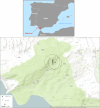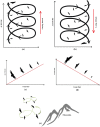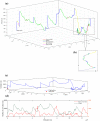Identification of Griffon Vulture's Flight Types Using High-Resolution Tracking Data
- PMID: 31007688
- PMCID: PMC6445529
- DOI: 10.1007/s41742-018-0093-z
Identification of Griffon Vulture's Flight Types Using High-Resolution Tracking Data
Abstract
Being one of the most frequently killed raptors by collision with wind turbines, little is known about the Griffon vulture's flight strategies and behaviour in a fine scale. In this study, we used high-resolution tracking data to differentiate between the most frequently observed flight types of the Griffon, and evaluated the performance of our proposed approach by an independent observation during a period of 4 weeks of fieldwork. Five passive flight types including three types of soaring and two types of gliding were discriminated using the patterns of measured GPS locations. Of all flight patterns, gliding was classified precisely (precision = 88%), followed by linear and thermal soaring with precision of 83 and 75%, respectively. The overall accuracy of our classification was 70%. Our study contributes a baseline technique using high-resolution tracking data for the classification of flight types, and is one step forward towards the collision management of this species.
Keywords: Animal movement; Animal tracking; Collision; Gliding; Linear soaring; Slope soaring; Spain; Spiral gliding; Telemetry; Wind turbine.
Conflict of interest statement
All data generated and/or analysed during the current study are available from the corresponding author on reasonable request.The authors declare that they have no competing interests.The experimental procedures of this study, including bird trapping and GPS tagging, were approved by the Consejería de Medio Ambiente of the Junta de Andalucía, who provided permissions for this research through the licence to capture and mark raptors to Antonio-Román Muñoz (Regional Licence: 65029 Consejería de Agricultura, Pesca y Medio Ambiente, Junta de Andalucía; National Licence 650038, Ministerio de Agricultura, Alimentation y Medio Ambiente).
Figures





References
-
- Barrios L, Rodríguez A. Behavioural and environmental correlates of soaring-bird mortality at on-shore wind turbines. J Appl Ecol. 2004;41(1):72–81. doi: 10.1111/j.1365-2664.2004.00876.x. - DOI
-
- Berthold P, Griesinger J, Nowak E, Querner U. Satellite tracking of a migrating Griffon Vulture in Spain. Satelliten-Telemetrie Eines Gänsegeiers (Gyps fulvus) in Spanien. 1991;132(3):327–329.
-
- Bildstein KL, Bechard MJ, Farmer C, Newcomb L. Narrow sea crossings present major obstacles to migrating Griffon Vultures Gyps fulvus. Ibis. 2009;151(2):382–391. doi: 10.1111/j.1474-919X.2009.00919.x. - DOI
-
- Biro D, Guilford T, Dell’Omo G, Lipp HP. How the viewing of familiar landscapes prior to release allows pigeons to home faster: evidence from GPS tracking. J Exp Biol. 2002;205(24):3833–3844. - PubMed
-
- Bohrer G, Brandes D, Mandel JT, Bildstein KL, Miller TA, Lanzone M, Tremblay JA. Estimating updraft velocity components over large spatial scales: contrasting migration strategies of golden eagles and turkey vultures. Ecol Lett. 2012;15(2):96–103. doi: 10.1111/j.1461-0248.2011.01713.x. - DOI - PubMed
LinkOut - more resources
Full Text Sources
